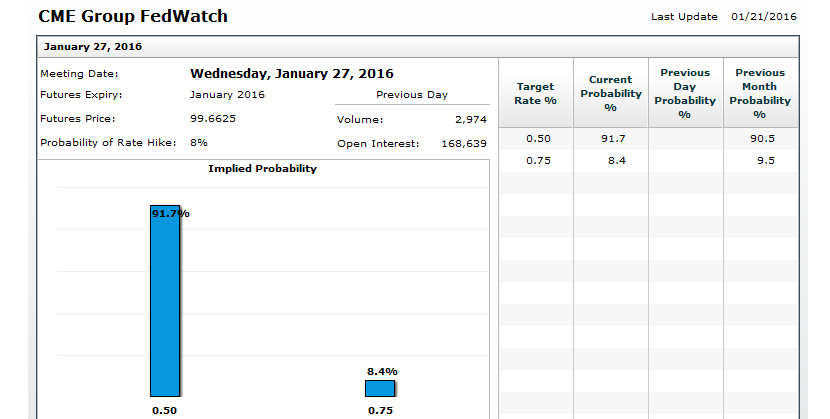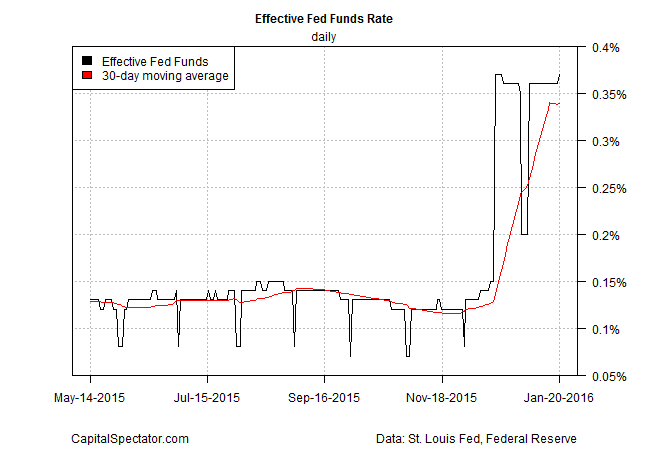Pondering The Fed’s Next Move
James Picerno | Jan 22, 2016 10:30AM ET
A Fed rate hike at a time when economic worries are on the rise? 'Fugetaboutit! In fact, some analysts are talking up the possibility that the central bank may be forced to back-track and reverse last month’s subtle but symbolically important 25-basis-point rate hike—the first since 2006. Perhaps, but there’s no sign of an imminent retreat in the effective Fed funds rate (EFF), which ticked up to 0.37% on Wednesday (Jan. 20)–the highest in a month. That’s an interesting talking point with next week’s Fed meeting on the radar.
Will the Fed raise interest rates at the Jan. 27 FOMC meeting? Unlikely, according to Fed funds futures. The implied probability that the monetary mavens will boost the target rate above its current 25-to-50-basis-point range is less than 9%, according to CME data for Jan. 21.

But while it’s not obvious that Janet Yellen and company are set to push the target rate higher, EFF’s latest move doesn’t hint at easing either. In short, the status quo is a reasonable bet, based on the numbers in hand.

In fact, monetary policy from the 30,000-foot-level continues to look mildly hawkish. The real (inflation-adjusted) monetary base (M0) ticked lower last month, dipping 2.8% vs. the year-earlier level. That marks the deepest decline in three years, although recent history makes it easy to set new records on this front given the generally huge increases in money supply of late. In any case, the latest numbers suggest that the Fed was front loading a modest squeeze in policy at last year’s close. But a lot has happened in the new year, at least in terms of market perception.
As hawkish monetary history goes, M0’s current profile is relatively trifling, of course. Nonetheless, students of economic history will note that the troubling sight of policy tightening at a time when the US macro trend is looking shaky, as discussed in yesterday’s business-cycle review. We’ve seen this movie before, or at least variations of the narrative. Is history repeating? It’s too soon to say, although there’s no monetary smoking gun at the moment via the Treasury yield curve, which remains positively sloped. What’s more, the case is still weak for arguing that the US has slipped into a new NBER-defined recession—based on a broad set of indicators through last month.
Recent updates, however, point to a degree of deterioration in the forward momentum. It could be noise. Much depends on how the next round of numbers for January compare—nonfarm payrolls in particular.
Meantime, the crowd is inclined to hedge macro risk a bit more aggressively in the new year. The 2-year Treasury yield—considered the most sensitive spot on the yield curve for rate expectations–continued to slip yesterday (Jan. 21), dipping to 0.84%–the lowest since last November, based on daily data via Treasury.gov.
What might reverse the revival of the safe-haven trade? Firmer economic numbers would do the trick… or renewed talk of monetary stimulus?
The Fed may be in no mood to comply, at least not yet, but the European Central Bank is again hinting at shoveling more liquidity into the system—with bullish results for stocks and oil prices, based on today’s early trading results in Europe in Asia. But a few hours of revival hardly add up to a decisive change.
“It’s a classic oversold bounce after Draghi’s comments yesterday and the noise on Japanese stimulus overnight, the question is where do we go from here,” Veronika Pechlaner at Ashburton Investments tells Bloomberg. “It’s become harder and harder for stimulus to really support the economic fundamentals so it doesn’t mean a medium- and long-term change, but at least we have a bit more stable trading environment for a couple of days.”
Trading in financial instruments and/or cryptocurrencies involves high risks including the risk of losing some, or all, of your investment amount, and may not be suitable for all investors. Prices of cryptocurrencies are extremely volatile and may be affected by external factors such as financial, regulatory or political events. Trading on margin increases the financial risks.
Before deciding to trade in financial instrument or cryptocurrencies you should be fully informed of the risks and costs associated with trading the financial markets, carefully consider your investment objectives, level of experience, and risk appetite, and seek professional advice where needed.
Fusion Media would like to remind you that the data contained in this website is not necessarily real-time nor accurate. The data and prices on the website are not necessarily provided by any market or exchange, but may be provided by market makers, and so prices may not be accurate and may differ from the actual price at any given market, meaning prices are indicative and not appropriate for trading purposes. Fusion Media and any provider of the data contained in this website will not accept liability for any loss or damage as a result of your trading, or your reliance on the information contained within this website.
It is prohibited to use, store, reproduce, display, modify, transmit or distribute the data contained in this website without the explicit prior written permission of Fusion Media and/or the data provider. All intellectual property rights are reserved by the providers and/or the exchange providing the data contained in this website.
Fusion Media may be compensated by the advertisers that appear on the website, based on your interaction with the advertisements or advertisers.